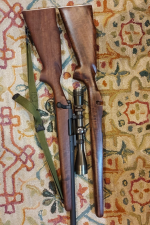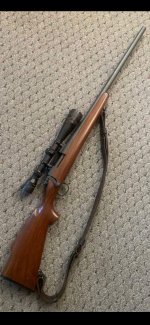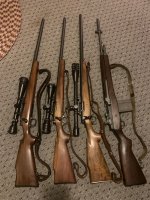This was covered on the M40 Forum long ago when Dep started making his prototype stocks. He modeled his stock directly from a Chuck Mawhinney edition M40 replica that Chuck was selling years ago (Marty had a bunch too). As I recall, the Chuck Mawhinney stocks were a copy of the SSA M40 stocks, which were a copy of an original USMC M40 stock. So, Dep had essentially copied a copy of a copy for his prototypes. He even copied the lightening cut that was in the barrel channel of the Chuck Mawhinney stocks. When he posted photos of that, he was told by forum members that wasn't a correct feature of the original USMC M40 stocks, so he filled it in and made a regular barrel channel.
Dep wasn't using a CNC or anything, at least not at first. In the beginning he was using a type of pantograph machine that he assembled wherever he was making the stocks. I'm pretty sure that Remington used pantograph machines to make the original USMC M40 stocks. A properly set-up pantograph can replicate one or more stocks at a time (depending on if it's set up for multiples), and produce a high quality product. Some light sanding afterwards and the stocks come out pretty damn uniform.
"I bet even at Remington if they had a good piece of walnut and there was going to be a defect at the very nose of an otherwise suitable piece of walnut they found a way." - pmclaine
Remington selected some nice wood for the original USMC M40 stocks, but they didn't just "find a way" or whatever if there was a defect. Even on the military stocks, if there was a defect, they didn't use it! I've owned more original USMC M40 wood stocks than probably anyone else in the world. Back when I was active on the M40 forum in 2016, I took measurements from about 7 original USMC M40 stocks in my collection, and posted the results on the forum (I've owned many more since then, but never updated the chart with new measurements). Using a caliper, I took measurements (the best I possibly could) from 27 different places on each of the original stocks, and then recorded the results in an easy to use table. The results were impressive, Remington was holding very tight tolerances for the original M40 wood stocks! The differences between them was almost negligible. So, Remington didn't just "find a way" to make a piece of wood work, they obviously took their job very seriously and produced some very high quality stocks for that time period!
"SSA may have built off a short original Remington M40 and Dep Taylor may have CNCd off of measurements from a long M40." - pmclaine
There is no long or short M40 stock, there are USMC M40 stocks and that's it. Everything else is just a copy or some other reproduction. I only have original USMC M40 stocks in my collection, I don't have any SSA, Chuck Mawhinney, Dep stocks or eBay stocks to compare to the originals. I have absolutely no idea why Dep's stock is longer than an SSA stock. Maybe the SSA stock is off and his stock is closer to the original M40 measurements. Maybe the Dep stock is off because he wanted to change the way it looked and functioned. He did make versions with DBM, so why not change something else if it makes the stock better for modern applications or something? Those are just some random thoughts of mine that mean absolutely nothing, because I don't have bo idea why the 2 stocks in the previous photos are different lengths. All I can say definitely is that there is only 1 USMC M40 stock (what collectors refer to as a Type 1), and that's that.
And before any asks me for this information........
Here it is:
Please keep in mind that this is as accurate and repeatable with each original USMC M40 stock as I could possibly make it. I've done an enormous amount of first-hand research with the entire M40 series of sniper rifles, all of which is has resulted in completely new information for the collector/historian community. M40 stock research like this has never been done before, this is all new information that isn't in any reference book.
If you're finishing a wood stock for your M40 clone build, please use the information I've provided below. Compare my measurements with the measurements from your stock and see how well they match up. The closer that your stock's measurements are to what I have listed in my chart below, the closer your stock will be to the original USMC M40 stocks.
The first two stocks on the chart (#3 and #14) are named after the rack numbers that were painted or stamped onto each of these stocks. The next four stocks on the chart are named after the last 4 digits of the original M40 serial number that was stamped on the bottom of the grip. If anyone needs information about the number stamps used on the bottom of the stock's grip, I can take measurements from the stamped numbers and post that information (clone builders might want to replicate these numbers on their stocks using the last 4 digits of their rifle's receiver serial number). The last stock on the list didn't have any identifying marks, so it's named after it's lack of numbers.
The 7 stocks are all in 5a row across the top of the chart. The 28 areas of measurement (of which only 27 are used) are all in a column down the chart. The A to Z letters in the chart correspond to the A to Z letters in the list below this paragraph. The list below tells you what measurement each letter represents. Since the list below isn't descriptive and concise enough on it's own, I also included photographs of an original USMC M40 stock with the A to Z measurements drawn onto the stock in the photos. Each line on the stock in the photos has a letter next to it, that letter can be matched up to it's counterpart on the descriptive list. All of this information is probably extremely obvious to you guys, but I still wanted to document everything in case some people had any questions.
One last note, in the photos below, you'll see 2 photos of the M40 stock's forend. This is not the same photo/information erroneously posted a second time, each of the 2 stock forend photos contains a different set of measurements. So, please look closely at them! Let me know if you guys have any questions about these M40 stock measurements, I'll do my best to answer them.
A. Length from the front of the recoil lug to the tip of the forend
B. Length from the tip of the forend to the center of the front sling swivel
C. Height of the stock at the tip of the forend (bottom of the stock to bottom of the barrel channel)
D. Height of the stock at the tip of the forend (right before it starts to taper off)
E. Height of the stock at the front sling swivel
F. Height of the stock midway on the forend (4 inches from the front of the recoil lug)
G. Height of the stock at the front of the recoil lug
H. Width of the stock at the tip of the forend (right before it starts to taper off)
I. Width of the stock at the front sling swivel
J. Width of the stock midway on the forend (4 inches from the front of the recoil lug)
K. Width of the stock at the front of the recoil lug
L. Width of the barrel channel at the tip of the forend (right before it starts to taper off)
M. Width of the barrel channel at the front sling swivel
N. Width of the barrel channel midway on the forend (4 inches from the front of the recoil lug)
O. Width of the barrel channel at the front of the recoil lug
P. Height of grip
Q. Width of grip
R. Circumference of the grip
S. Grip protrusion below the stock
T. Length of thumb cut on the cheek piece
U. Length of cheek piece
V. Height of cheek piece
W. Width of cheek piece
X. Height of butt
Y. Width of butt
Z. Length from end of the butt of the center of the rear sling swivel
OAL – Stock overall length (without buttplate)
Arc – The arc of the grip (I never got around to measuring this area of the stock, so there isn't any arc information recorded on the chart)
View attachment 8337279
View attachment 8337280
View attachment 8337281
Yellow highlight = bedding material throws off the measurements
Yes, I still have all the information I ever posted on the M40 Forum, nothing of mine is lost.......




